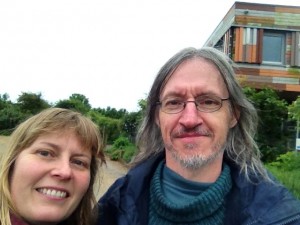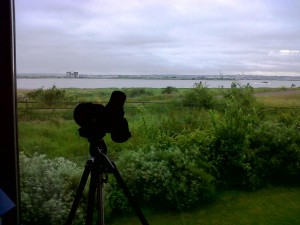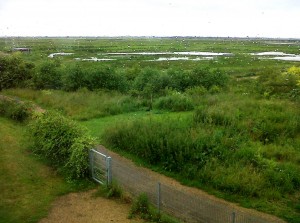Local Nature Reserve Managers Karen Sutton (Crossness) and Chris Rose (Thames Road Wetland, Vice-Chair Bexley Natural Environment Forum) went over to the ‘dark side’ today (aka Essex) to discuss with staff at RSPB Rainham Marshes the measures that might be taken to increase favourable nesting habitat for declining waders like Redshank and Lapwing on our side of the river in east London.

It’s not all hard work up to your armpits in mud ….. Karen and Chris pose for the de rigeur ‘selfie’ at RSPB Rainham
Size does matter, and not having been to Rainham before, I was struck by just how much bigger an area it is compared to the tiny fragments of marsh and wetland we have left on our side of the water within the London boundary. Whilst reproductive success has increased significantly at Rainham with the introduction of electric fencing to minimise Fox predation, a discussion will need to be had about whether this would be the best use of resources at Crossness given difficulties with other key issues such as maintaining the necessary water levels and juggling the grazing regime. It may be that work targeted at other species such as Cuckoo and Turtle Dove would be more appropriate.
It was no surprise, since they are both right opposite Rainham, that discussion turned to a longer term vision of bringing Crayford and Dartford Marshes into conservation management, as these hold out much greater promise size-wise, and if the clout of the RSPB could be brought to bear perhaps the progress on that – which appears to be stalled at present – could be got going again. It’s certainly something one might have hoped would be happening under the umbrella of the ‘Greater Thames Marshes Nature Improvement Area’ (which, rather bizarrely, excludes Swanscombe Peninsula and Dartford Marshes, but includes Crayford and Erith Marshes). A reciprocal site(s) visit for the Rainham team to get a closer look at what the marshes on our side of the river have to offer may therefore be in the offing in the not-too-distant future.

‘Grey sky thinking’ – this view out over the Thames sees the Darent flood defence barrier and Dartford Marshes to the left, and Crayford Marshes to the right. The ‘landscape level’ approach to re-building natural capital would see these areas mirroring some of the habitat improvements and availability of Rainham to the north, whilst conserving the distinctive features of their own. After all, for your rare bird struggling to find somewhere to make a living, it’s a just a short commute over a river from one of these sites to the others ….
As to the birds on view while we were there, the best sighting of a damp grey morning was of a male Bearded Tit which flew across a boardwalk just in front of us, and landed in reeds close by, where good binocular views were had. There were impressive numbers of Little Egret and many Swifts zooming overhead, as well as plenty of Lapwing and some Pochard, which latter are pretty much absent from Bexley water-bodies at this time of year.
We are grateful to Alan Johnson and Les Edwins of the RSPB for their time and the great deal of useful site management information imparted.
(Chris Rose)

